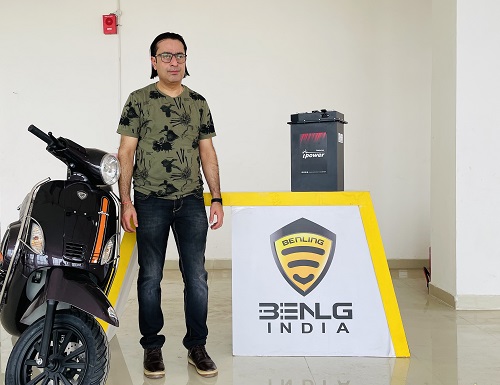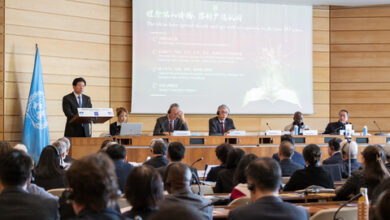LFP Battery Breakthrough, a Sustainable Innovation in Electric Vehicles that could Make it to Market Soon: Benling India
The most likely innovation in Indian Electric vehicles looks like it will be in-market soon, is linked to fast-charging batteries, i.e., LFP or Lithium iron phosphate, which charges 80 percent in just about 15 minutes. Nearly 80% of lithium-ion battery demand comes from the Electric Vehicle market. Last year, LFP outsold NMC among batteries, sold by major Battery manufacturers globally. The market share is growing through the year: of 100GWh of lithium batteries used for EVs and Energy Storage systems, 44% were NMC and the majority of the remainder LFP. As per industry experts, LFP will be the dominant battery chemistry over nickel manganese cobalt (NMC) by 2028, in a global market of demand exceeding 3,000GWh by 2030. This LFP battery technology breakthrough will spread across India in the next 24 months.
 |
Mr. Amit Kumar, CEO & ED, Benling India proudly displays fast-charging LFP Batteries
Benling India, a Make in India dedicated E2W manufacturing company based out of Gurugram, outlines the importance of LFP Batteries in Electric two-wheeler segment with key concerns in Electric Mobility. The EV automaker is transitioning towards LFP batteries for its entire E2W range within 2022. The root of its LFP battery technology stems from its parent company, which produces and supplies LFP batteries in 84 countries, and has a production capacity of 1 lack units annually. Mr. Amit Kumar, CEO & ED, Benling India shares an expert perspective.
Safety advantages, long lifecycle, and lower costs have led EV makers to accept the trade-off of lower energy density in adopting LFP batteries. Also, the zero-emissions transport policies rolled out in response to rising fuel costs are ‘causing demand for lithium-ion batteries to skyrocket‘. The comprehensive shift in actual battery chemistries is building at scale with new demand, more investments, perhaps innovations in manufacturing itself, and multiple regulatory hurdles to cross.
LFP Battery is the answer to Electric Mobility in India. Its advantages make it an attractive option in power and energy applications over the more mature market technology of traditional NMC (nickel manganese cobalt) batteries. Both are Lithium Batteries, but they are very different in their constitution. The nickel and cobalt metals, as critical raw materials for NMC batteries, have met difficulties recently. Nickel supply has been affected by the conflict between Russia and Ukraine, while cobalt, due to flooding in South Africa that led to the suspension of the Durban port, is challenged by potential global cobalt supply chain disruption. But LFP supply chain is more stable compared with NMC batteries. And coupled with lower cost, LFP battery has become the star of the EV market globally.
A lithium iron phosphate (LFP) battery is a lithium-ion battery using lithium iron phosphate as the cathode material. Thus, by doing away with cobalt, it makes products that much more sustainable. In terms of performance, it can charge and discharge at high speeds compared to other types of batteries. Additionally, it has several distinctive features, such as a low discharge rate, less heating, and a higher number of charge cycles. Moreover, LFP batteries are environmentally safe and structurally stable. The chemistry of the battery saves it from thermal runaway, and hence it is safe for home use. With all those merits, the adoption of LFP batteries has gained traction.
A battery that is a bit larger than the current NCM batteries can still be cheaper. LFP batteries are heavier and need more room, but the battery space is big enough for a standard long-range battery. The LFP offers efficient heat dissipation for better thermal stability, especially during quick acceleration and long rides. The battery pack must provide high-temperature resistance given Indias tropical weather conditions. Other advantages include
-
Improving electronic components stability.
-
Providing a better acceleration experience.
-
A better slope climbing ability.
-
No active maintenance.
In the face of carbon peaking and carbon neutrality strategies, LFP batteries will become increasingly important in the electric vehicle market and will also likely play a role in the energy storage market. It can be reasonably predicted that the LFP battery will have massive potential shortly. Supply chain issues besetting the battery market are not likely to ease during 2022, particularly with EV demand rising in reaction to the rising price of oil and the ongoing raw materials commodity crunch. Nonetheless, many more new plants for battery manufacturing are expected soon.
Battery technology has also been evolving, throughout history, in the desire to make it more efficient, robust, dependable, and sustainable. The lithium-ion batteries-saga is as old as the 1970s and is still improvising. However, a big complaint from industry analysts is the slow transfer of these innovations from the lab to the market. For them, innovation is not worthwhile until it hits the market and makes a real difference in price, efficiency, safety, or all three.
For more information, please visit www.benlingindia.com.
![]() This feed is automatically published via newsvoir.com
This feed is automatically published via newsvoir.com


